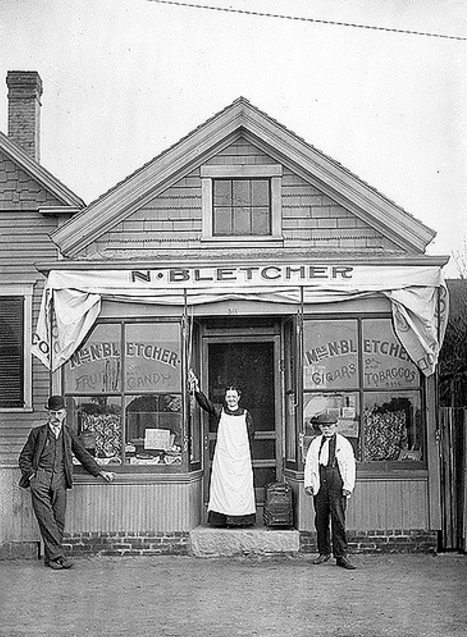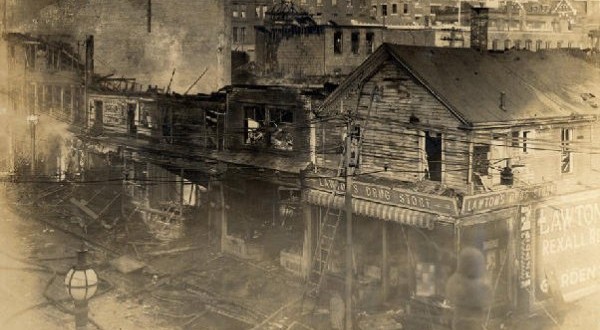Welcome to next installment in the New Bedford Streets; A Piece of Americana series. Previously we covered William Street, Kempton Street, Middle Street, Centre Street, Ashley Boulevard, Elm Street, Coggeshall Street, Mechanics Lane, Washburn Street and many others. If you would like to read those or perhaps revisit them, they can be found by using the search bar to the right. You can also select the “Streets” category.
As usual, I’d like to re-iterate the importance of reader feedback, correction, and contributions. In the process of exploring these streets, I try to confirm or validate statements and dates by finding multiple sources. Unfortunately, if all those sources are making their statement based on an older, incorrect source, and there isn’t any dissenting information available, there’s no way to know otherwise. So by all means, please join in.
In addition, when trying to validate some statements, often there is very little to no information available. I haven’t decided which is worse – finding one source, or finding multiple sources, but not knowing if they were all founded on an inaccuracy. So help from local historians, those who remember, oral histories and anecdotes handed down through the generations, people with private collections, and even know-it-alls will help!
By all means, let us make this an open discussion to keep the “wiki” accurate.

Barkers Lane is to the right of the photograph and this is looking down Acushnet Avenue where the Globe Building was in the 19th century. (Spinner Publications)
For those who aren’t 100% sure where Barkers Lane is, it is the one block long street that separates the Custom House Park from the “back end” of The Garden in the National Historic Park downtown. There is next to nothing recorded about this street. I have a folder with about 100 links to various aspects of New England, Old Dartmouth, and New Bedford history and go through one at a time. Usually by link number 30 I have enough information, that I need to start to cull the pertinent bits – making the remaining links either subordinate or altogether redundant.
In the case of the keyword “Barker,” I utilized every single historic link I had, exhausted Google, and Spinner Publications and I was left with very little in terms of the origin of Barkers Lane. In fact, confusing matters even worse is that in the 1909 “Directory of New Bedford: Of the Inhabitants, Business Firms, Institutions, Streets, Societies,” it is referred to as Barkers Court, in spite of the fact that it is called Barkers Lane in an 1895 map.
Where did the name come from?
Was this short strip of road called Barkers Lane originally and became Barkers Court for a short period of time before being referred to as Barkers Lane again? Or was it originally referred to as Barkers Court and became Barkers Lane and it took some time for the older name to die out, since it was called a court by whatever old-timers still persisted?
Looking up Barkers Lane on the City’s Parcel Lookup page, muddling matters even further by calling it “Barker’s Lane.” Compounding that, the word “barker” has more than one meaning, in fact, there are four possibilities. Barker is either a surname, a task, or it is a occupation. As a task, it refers to someone who strips bark from a tree? Who does that? Well, a leather tanner does that, which brings us to our occupations. A leather tanner specifically uses bark in the process. Tanning and the word tannin are of the same root and bark contains the necessary tannins needed to turn skins into leather. Finally, a person who stood outside a theater, venue or business and talked to passer-bys to encourage them to enter was called a barker.
So does the street signify that a member or members of the Barker family lived on that street and named it after their family name? Was it called that because at one time there were some shops whereby a number of barkers stood outside their businesses and called to potential customers and punters? Or was it a street that had some tanneries?
Historical records are of no help. At least, the ones that I have access to. Which isn’t comprehensive by any means.
Could the Barker Family which goes back to the Mayflower be the source?
Could it be named after a family? Does the surname Barker play any role of import in the region? An important enough one to merit having a street named? The Barker family is not only an important one in the nation’s history, the Barker family did play a prominent role in New Bedford’s history. The first Barker to arrive in the country was actually a passenger on the Mayflower, Elizabeth Winslow Barker, wife of Plymouth Colony’s governor Edward Winslow and one of the signers of the Mayflower Compact and fellow Mayflower passenger.
In the 18th-19th century, Barkers of a different familial line than the Mayflower passenger, were widespread throughout greater New Bedford to Rhode Island. They were farmsteaders, landowners, firemen, surveyors, constables, merchants, captains and politicians.

Barkers outside Allen’s theater – their job was to encourage or convince people to come inside and spend money.
In fact, an entire book could be written on the Barker family’s presence in America in general, and specifically the greater New Bedford area. The Barkers would marry into the Russell, Gifford, Howland, Borden and Tripp families throughout the early part of the 18th century and thus would be their connection to our neck of the woods. Their relationships with this families is interesting in their own right, but far beyond the scope of this article.
Suffice it to say that they not only intermarried with old families in the New Bedford area, they worked, lived, owned business and properties in New Bedford. They certainly merited streets being named after them, but none of the lived on that street. They lived on Grinnell, County, Fourth, and South Sixth Streets, but not near Barkers Lane.
What is the precedence for street names that are surnames because of affluence or prominence? William, Beetle, Alden, Kempton, Brownell, Russell, Arnold are surnames, but notice that they are all singular? I think it would be safe to say that if the “Barker” in Barkers Lane was a surname it would be called “Barker Lane.”
Barker as an occupation?
Since stripping bark as a task, was one of the job duties of a tanner, it is safe to merge them as one. So, we are left with the barker being that annoying fellow who tries to convince you to come into his business or the leather tanner. What do historical records say were located in this area? The best thing we have is a map from 1895 and the 1909 New Bedford Directory. What we know is that where the Custom House Park is today, were three businesses: The Globe Building, the Germania House, and the Evening Journal.
The New Bedford Evening Journal was a newspaper that ran from 1890-1893, you can actually read these online here. It ran parallel to Barkers Lane, but its front was at North Second Street. The Germania Building was a meeting house for the German speaking, fraternal organization, the Improved Order of the Red Men. At one point in the city’s history, there were a lot of Germans – equivalent to what we see with Portuguese in the city today. There were restaurants, opera houses, choirs, social clubs, festivals, and other cultural contributions. This building was smack dab in the center of the block.

Proprietor and barkers outside of N. Bletcher Store.
Lastly, the Globe Building – originally a newspaper, later a theater, ran the length of the block from 348-362 Acushnet Avenue, following what the Boston Globe did in Boston having the Boston Globe at 244 Washington Street and the Boston Evening Transcript at 324 Washington. I am not sure if there is a connection or it’s just coincidence.
Could there have been leather tanners before 1895? Certainly and very plausible. Could it be that people stood out front of these newspapers and called out to people to purchase editions? Also, plausible. Considering that New Bedford’s premiere shopping destination, Cheapside was 2 blocks away and Market and Purchase Streets were only a block away, it seems that is incredibly likely that the “Barker” in Barkers Lane, has to do with people standing outside their business trying to convince people to purchase something in their store.
Is there another Barkers Lane somewhere on the planet that could shine some light on our Barkers Lane? There is one other Barkers Lane on the planet that I could find. It won’t surprise you that this Barkers Lane is a shopping strip jam packed with various shops and services, e.g. supplies, hairdresser, cafes, pubs, car dealership, etc. Even more telling is that along this strip and the street it converges into is considered to be an entertainment complex with places like a Bingo hall and cinema.
Where is this only other place that has a Barkers Lane located? Would you believe, Bedford, England, the very place where the city’s “founder” Joseph Russell III’s family name originates?
 New Bedford Guide Your Guide to New Bedford and South Coast, MA
New Bedford Guide Your Guide to New Bedford and South Coast, MA









Your do such a great job researching the city I have a question on research I would like to know where was Grand Army of the Republic ( GAR ) post one in the city. New Bedford had post one and figured so prominently in the Civil War and the tiny stretch of RT 6 is GAR high way. I have tried to find where it was to to no avail.
Thanks for the historical information on the Barker’s Lane. It is very interesting to us at WHALE (Waterfrontl Historic Area League) as we are rescuing two buildings, 139 & 141 Union Street which the back doors are on Barker’s Lane. These two buildings had been vacant for a long time.
WHALE put a new roof on 139 Union to save it from further deterioration. This building will become a Co-Creative Center in partnership with AHA!, Art Museum/Artworks, and studio2sustain.
@Brian,
Thanks a bunch for the kind words.
The GAR Post One was located at 736 Pleasant Street – near the Bus Terminal and Bank of America. I believe it is a parking lot now.
I hope that helps!
Diane,
Thanks also for the kind words. We at NBG love the work WHALE does! 139 is the old Berk’s Militaria, correct? I was under the impression it was owned by a local businessman whom I won’t name for privacy reasons, and was to be made into a Tea House or something.
Glad to see those buildings are going to be saved. I look forward to see the work unfold.
Maybe this with help..My father Frederick Gordon Barker and his sister Emily Barker( Mello) grew up on Pleasant St. Their Dad Fred Barker ancestors French and English born in England married Emily King ancestors from the Azores. My Grandfather owned a diner Called Barker’s Diner in New Bedford….not sure where. My Aunt was a great historian before her passing and was always donating photos to your local papers.